Three Types of Reclaimed Wood Exterior Siding
Exterior siding has been a part of home design for centuries. It comes in many different looks, but the principal purpose is to make the interior habitable while keeping the harsh weather conditions out. Even with unique applications, different styles of paneling invoke a vintage nostalgia feeling for homeowners. For most parts, most siding panels stay within the three-eighth (⅜”) inch thickness for ease of installation. Various lengths and widths help bring out different looks to achieve the design a homeowner wants. Different exterior siding types require different levels of woodworking expertise. The most common exterior siding materials are vinyl, wood, aluminum, or concrete. With the upcycling trend becoming more popular, designers have preferred reclaimed wood as their favorite medium for exterior paneling. Even though there are different varieties of siding applications, the three most common types of exterior siding are: shiplap, overlap, and tongue and groove siding.
Shiplap Siding
The shiplap style was invented centuries ago by the Vikings, back in the 8th to the 11th century. The original purpose of shiplap, which derived from its name, was to build ships, both war, and merchant ships. Even with its lasting history, shiplap siding exterior only became popular as paneling in the 18th century. In the early 1900s, many individuals started adopting this type of siding to build their homes by the shores. With moisture from the sea coming in, the wood would expand, thus preventing the cold from entering the home. This exterior siding method would also stop the cold from the sea breeze, making the interior more cozy and habitable. Shiplap provided great defense for their homes against harsh weather conditions. Since then, many people have been building barns and farmhouses using the shiplap method due to its effectiveness and ease of installation.
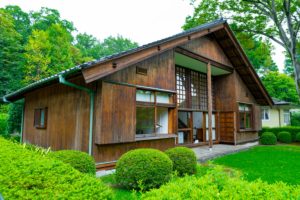
Shiplap exterior siding generally comes in long horizontal boards with rabbet joints at both ends. This paneling technique allows a plank to interlock with one another, stacking up like a jigsaw puzzle. This helps prevent water from heavy storms from invading one’s home. Because of the identical rabbet joints, it is easy for DIYers with the right tools to do the installation themselves. For shiplap siding installation, only simple woodworking skills are needed to do the job. Yet, for a more intricate layout, a professional installer is needed. For this paneling style to be most functional, it should be installed vertically or horizontally.
In recent years, shiplap exterior siding for homes has become more popular amongst California residents as decorative accents for the interior and exterior wall panels. Because of their thickness of about three-eighth (⅜”) to eleven sixteenth (11/16”) of an inch, they are great for accenting interior walls. Either accenting a wall or accenting the entire house, shiplap panels create a warm and vintage look to a home. Because of the growth in modern designers’ and DIYers’ demands, shiplap paneling comes in different sizes, ranging from 1×5” to 1×12 ” with the most popular being 1×6” and 1×8” shiplap exterior siding. The length of each panel can vary, with some short pieces starting at 6’, while others can be up to 12’.
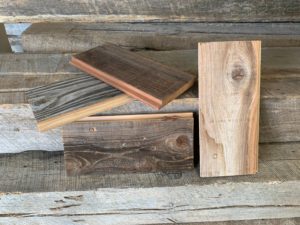
(Exterior Shiplap Siding by True American Grain)
The materials for the shiplap siding exterior have diversified as well. The most common materials used for shiplap panels are vinyl or wood. Each offers a one-of-a-kind characteristic while appeasing different audiences. Many shoppers ask whether vinyl exterior shiplap or wooden shiplap would be better for external applications. There is no clear answer to the question, but at the end of the day, it would come down to the look that an individual is trying to achieve. Vinyl siding, either dark or light tone, provides a more modern look to one’s residence, while the wood siding creates a warm and soothing feeling for the homeowner. One main advantage of using vinyl shiplap for exterior siding is it defends the home against destructive pests from damaging the home. On the other hand, wooden siding grants an aesthetically pleasing look for its residence. The most common wood types for shiplap panels, which most harmful bugs hate, are pine, redwood, and cedar.
With the upcycle trend, reclaimed wood shiplap has become a choice many prefer when choosing wooden exterior panels. Old barn boards are a contemporary homeowners’ favorite shiplap paneling material due to the rugged look. Furthermore, new wood siding does not offer the same nostalgic feeling that reclaimed wood lumber does. Besides the aesthetic, newer wood shiplap can last about 20-30 years, while reclaimed wood panels can survive an extra 100 years because of their ability to withstand weather conditions and resenting bugs.
Overlap (clapboard)
It was hard to pinpoint the exact age of overlapping siding, but the application has been around since the 17th century. The earliest indication of overlap siding in North America was from the first American colonists, brought from Europe to the New World to build barns to withstand harsh weather conditions, especially the rainy seasons. However, they were not as popular as the shiplap paneling application back in the day. Until the Industrial Revolution in the 1850s, the clapboard siding became much more popular due to the Victorian era taste. Clapboard paneling got used in regular residences, cabins, and plantation houses.
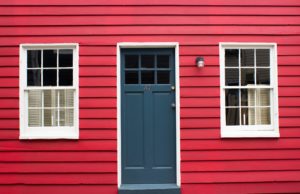
The name overlap siding comes from the way it is installed. One panel overlaps another from the long side to create dropdown layers that cover an exterior wall. The upper planks will sit nice and tight on the planks below to seal the space between them airtight. This type of siding is well-liked for many reasons, such as ease of installation and substantial water-resistant ability. Because of its design, overlap paneling allows water to run downward with zero chance of penetration through the surface behind. When the rainy season arrives, water will pour down alongside the panels. Like a roof, overlap siding will brush off any water without leaving a drop stuck between two planks.
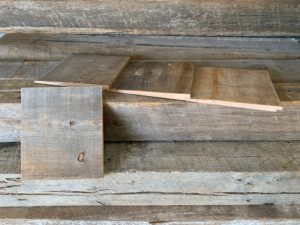
(Exterior Overlap Siding by True American Grain)
Unlike other paneling options such as, shiplap paneling, and tongue and groove exterior siding, installing overlap should be done horizontally in order to achieve its useful purpose. It is rare for someone to install overlap vertically, but there have been projects designing overlap panels tacked side by side to create a welcome atmosphere. However, this application is more suitable for the indoor setting because this method can compromise its function. DIYers do not need expert level woodworking skills to install a simple layout of clapboard exterior siding. Yet, an expert should be consulted for a more complex design.
In the contemporary setting, the clapboard look ranks highly in consumer choices for exterior siding. In contrast with the two other siding options, overlap receives more interests in residential applications in the urban area. Due to its association with the Victorian design, , it provides a classical yet simple look for those who have a taste that enjoys the blend of modern and classic. For an aesthetic appeal, many manufacturers produce planks with a nominal thickness of around ⅜” of an inch for ease of installation. Widths can range from 1×6” to 1×10”, with the popular size being 1×8” overlap exterior siding. The panels’ lengths may vary, but many prefer a 12-foot-long plank. For most installers, the benefit of cutting a long piece into favorable small lengths is more practical than using smaller planks which may end up with too much waste.
Besides wood being the dominant siding material, vinyl, aluminum, and concrete have become more popular exterior siding materials. As mentioned above, vinyl and wood siding generates certain feelings for a homeowner. Overlap exterior siding materials can be aluminum and concrete as well. While aluminum siding is easy to maintain, concrete siding, which does not expand or contract easily when the weather becomes too hot or cold, can be very durable to withstand harsh conditions.
Reclaimed wood overlap siding has become more and more popular in southern California because of its relation with the Victorian era style. With the rugged charm that reclaimed lumber brings to the table, many residences choose reclaimed barn wood over new wood to add warmth and a more aesthetic pleasing appeal to their homes.
Tongue and Groove
Tongue and groove siding has been around for centuries, and it can be dated back to the beginning of the Civil War. In the past, people constructed shelters out of wood chiseled logs, in a tongue and groove style, which was a popular way to build houses. In the United States, until the 17th and 18th centuries, major residential construction used this type of paneling as their preferred method to apply exterior siding. It was first popularized on the East Coast due to its versatility.
The tongue and groove paneling style has planks with an inner piece of wood sticking out (“tongue”) and an opened slit (“groove”). The tongue of an upper plank will interlock with the groove of the lower plank to create a paneling look. A huge advantage that tongue and groove siding has against shiplap is that the planks above will fit tightly together with the one below, which prevents air from coming in. Despite the fact that this type of siding looks like shiplap siding, its older sister, tongue and groove paneling is famous for its durability due to its interlocking system. It is harder for water to penetrate through this type of siding. Due to wood expanding when wet, the joints absorb some moisture and seal the gaps even tighter. As for installation, it is recommended to have a professional installer put together tongue and groove siding. DIYers can do it themselves, as long as they have intermediate woodworking skills. The tongue and groove paneling can be installed horizontally or vertically; however, some creative designers will style their walls with either fishbone or herringbone designs.
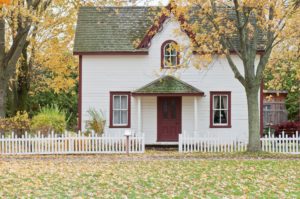
More recently, many siding lovers have sparked a debate of whether the shiplap or tongue and groove paneling is better. Even though the aesthetic look is the same, the installation mechanism is the main difference. The benefit of shiplap is the ease of installation, whereas tongue and groove siding has a stronger bond. Similar to its shiplap paneling sister, its size can run from 1×5” to 1×12”, with a thickness around ⅜” to 11/16”. The most on-trend size right at the current moment is 1×8 tongue and groove siding. The length of each panel can vary, with the shortest being 6 feet, whereas the longest being 12 feet. Many modern homes prefer a longer plank to create a complete look, either top-down or side to side. On the other hand, some designers prefer a mosaic effect on their walls.
Back in the day, the typical medium for this type of siding was rot-resistant wood, such as cedar, redwood, or cypress. In the present day, those softwood types are still preferable siding materials. With modern pressure-treated wood introduced, homeowners love to have their siding having an additional layer of protection against harsh weather conditions and those nasty pests.
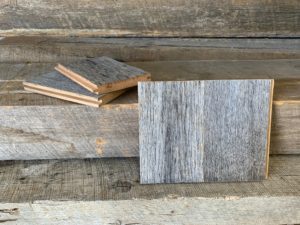
(Exterior Tongue and Groove by True American Grain)
With reclaimed wood being a trend recently, many homeowners, especially in the western states, want to redecorate their homes with reclaimed wood siding. Tongue and groove reclaimed wood paneling is among the most popular exterior siding types that many consumers prefer. Adding a paneling layer to the outside walls means that homeowners not only lend warmth to their homes but also add to the resale value of their houses.
For centuries, exterior siding has played an undeniable role in home design. They came from different regions in the world and got popularized in America in the 17th and 18th centuries. Besides keeping out harsh weather conditions, exterior paneling offers a warm feeling for one’s residence. With the most common size being 1×8 exterior siding and various lengths, designers like to play around with the layout to get the most appealing look while maintaining the purpose of the exterior siding. With 3/8th thickness, installers can easily install an accent wall using the right tools. Even though different types of siding require different levels of woodworking skills, it can be done by DIYers, if it is just a simple horizontal or vertical layout. Common exterior siding materials are vinyl, wood, aluminum, or concrete. Piggybacking on the upcycle trend, designers prefer reclaimed wood as their favorable material for exterior paneling. Nowadays, the three most common exterior siding types are shiplap, overlap, and tongue and groove siding.
At True American Grain, we pride ourselves on exceptional quality service. We provide quality reclaimed wood products, including reclaimed barn wood, interior wood panels, three-quarter of an inch thick (¾”) exterior wood siding, solid beams, solid mantels, box-built beams, box-built mantels, reclaimed wood shelving and many other custom-built projects. Our exterior reclaimed wood siding comes in three different designs, the California Coastal, the Kentucky Bourbon, and the Big Sky Gray.
Stop by our showroom and chat with our design associates for more information!
